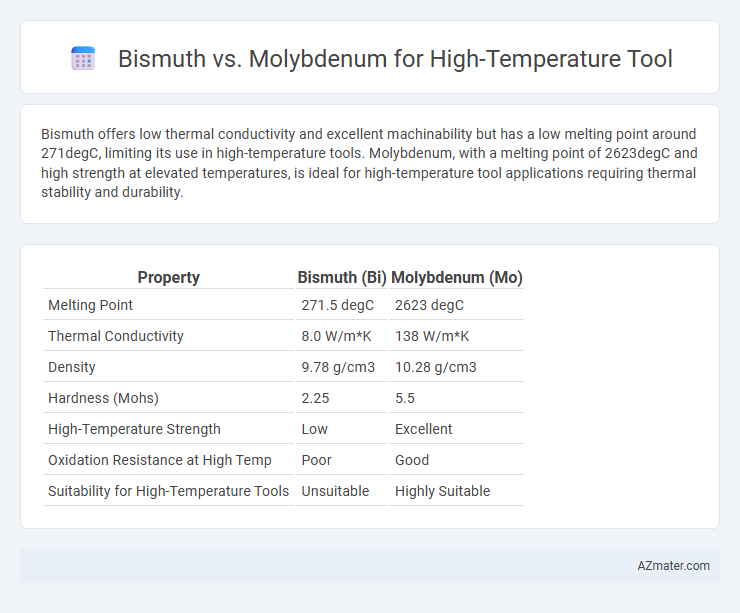Bismuth offers low thermal conductivity and excellent machinability but has a low melting point around 271degC, limiting its use in high-temperature tools. Molybdenum, with a melting point of 2623degC and high strength at elevated temperatures, is ideal for high-temperature tool applications requiring thermal stability and durability.
Table of Comparison
| Property | Bismuth (Bi) | Molybdenum (Mo) |
|---|---|---|
| Melting Point | 271.5 degC | 2623 degC |
| Thermal Conductivity | 8.0 W/m*K | 138 W/m*K |
| Density | 9.78 g/cm3 | 10.28 g/cm3 |
| Hardness (Mohs) | 2.25 | 5.5 |
| High-Temperature Strength | Low | Excellent |
| Oxidation Resistance at High Temp | Poor | Good |
| Suitability for High-Temperature Tools | Unsuitable | Highly Suitable |
Introduction to High-Temperature Tool Materials
High-temperature tool materials require exceptional thermal stability, oxidation resistance, and mechanical strength to maintain performance under extreme heat. Molybdenum is widely used due to its high melting point (2,623degC), superior thermal conductivity, and excellent strength at elevated temperatures. Conversely, bismuth, with a much lower melting point (271degC), offers limited applications in high-temperature tools, primarily serving as a low-melting additive in alloys rather than a primary structural material.
Overview of Bismuth and Molybdenum
Bismuth is a heavy, brittle metal with a low melting point of 271degC, known for its excellent thermal expansion properties and use in low-temperature alloys and fusible plugs. Molybdenum is a refractory metal with a high melting point of 2623degC, exceptional strength, and thermal stability, making it ideal for high-temperature tool applications such as cutting tools and furnace components. While bismuth offers advantages in thermal expansion and machinability, molybdenum's superior melting point and strength make it more suitable for extreme high-temperature environments.
Thermal Stability: Bismuth vs Molybdenum
Bismuth exhibits low thermal stability with a melting point of 271degC, making it unsuitable for high-temperature tool applications where heat resistance is critical. Molybdenum offers exceptional thermal stability, maintaining structural integrity at temperatures exceeding 2,600degC, which is vital for high-temperature tools used in demanding industrial processes. The superior melting point and thermal conductivity of molybdenum significantly enhance its performance under extreme heat compared to bismuth.
Mechanical Properties Comparison
Bismuth exhibits low melting points and poor mechanical strength at high temperatures, limiting its use in high-temperature tools. Molybdenum offers superior mechanical properties with high tensile strength, excellent thermal stability, and resistance to creep and oxidation above 1000degC. This makes molybdenum the preferred choice for high-temperature tooling applications requiring durability and structural integrity.
Oxidation Resistance at Elevated Temperatures
Bismuth and molybdenum differ significantly in oxidation resistance at elevated temperatures, with molybdenum demonstrating superior performance due to the formation of a protective molybdenum oxide layer that limits further oxidation. Bismuth, being a post-transition metal, tends to oxidize more readily and lacks a stable oxide protective layer, leading to faster degradation during high-temperature applications. For high-temperature tools, molybdenum's oxidation resistance enhances durability and longevity under oxidizing conditions.
Machinability and Fabrication
Bismuth offers superior machinability for high-temperature tools due to its low melting point and excellent chip-breaking properties, reducing tool wear and enhancing surface finish during fabrication. Molybdenum, while possessing high thermal stability and strength at elevated temperatures, presents challenges in machining because of its hardness and brittleness, often requiring specialized cutting tools and slower feed rates. Fabrication of bismuth-based alloys is generally easier with conventional processes, whereas molybdenum demands advanced techniques like powder metallurgy or electron beam melting to achieve desired tool geometries.
Cost and Availability Analysis
Bismuth offers lower raw material costs compared to molybdenum, making it a more economical choice for high-temperature tools where budget constraints exist. Molybdenum, however, boasts superior availability in industrial markets due to its widespread mining operations and established supply chains, ensuring consistent procurement for large-scale manufacturing. The cost-effectiveness of bismuth is offset by its relatively limited availability and less developed supply infrastructure compared to molybdenum's robust commercial presence.
Typical Industrial Applications
Bismuth is primarily used in low-melting alloys and as a coolant additive due to its excellent thermal conductivity but limited high-temperature strength. Molybdenum excels in high-temperature tools such as cutting inserts, furnace components, and aerospace parts because of its superior melting point (~2623degC) and resistance to thermal creep. Typical industrial applications favor molybdenum for tooling exposed to extreme heat, while bismuth alloys find niche uses in thermal management and safety devices.
Environmental and Safety Considerations
Bismuth offers a non-toxic, environmentally friendly alternative to traditional heavy metals, making it safer for high-temperature tools used in sensitive environments. Molybdenum, while effective at high temperatures, carries concerns related to its mining impact and potential toxicity during manufacturing and disposal. Choosing bismuth-based alloys reduces the ecological footprint and enhances worker safety by minimizing hazardous exposure risks.
Summary: Choosing Between Bismuth and Molybdenum
Bismuth offers excellent machinability and low toxicity, making it suitable for high-temperature tools requiring precision and safety, though it has lower melting points and mechanical strength compared to molybdenum. Molybdenum excels in strength, thermal conductivity, and resistance to thermal expansion at elevated temperatures, ideal for demanding industrial applications involving extreme heat. Selecting between bismuth and molybdenum depends on balancing thermal performance requirements with material robustness and compatibility in specific high-temperature tool environments.

Infographic: Bismuth vs Molybdenum for High-temperature tool
 azmater.com
azmater.com